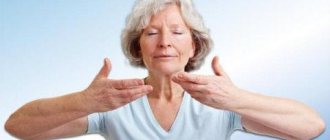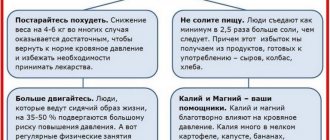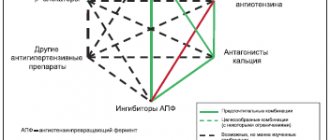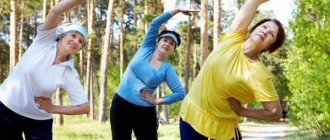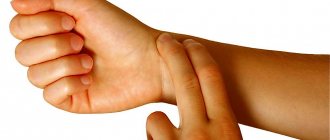06/28/2021 | Category Hypertension
In helping his patients, Dr. Shishonin adheres to the key principles of natural healing. It should be remembered that:
- the body is truly capable of coping with almost any problem, usually you just need to help it a little;
- no pills or other artificial medicines will surpass in their effectiveness what has already been created by nature;
- and even more so, most problems do not require surgical treatment - operations can cause harm more often than it seems.
For many people, hypertension, that is, a critical increase in blood pressure, has become an urgent problem. And for some reason, many are sure that nothing can be done in this situation, that treatment must necessarily involve taking medications or, even worse, heart surgery.
Meanwhile, there are much simpler, safer and moreover effective methods. These are breathing techniques that help lower blood pressure when it changes sharply. Or rather, not so much to reduce as to normalize - this is an important clarification, since some people, on the contrary, need to increase their blood pressure in order to bring it back to normal.
Air is life... and energy
So, where to start when talking about practices to normalize blood pressure? First of all, you should know that any deep and slightly rapid breathing will reduce it at the time of a hypertensive crisis. This happens primarily because the supply of oxygen to the brain increases.
Oxygen, as everyone knows, is an atmospheric gas, a substance of natural origin that can affect the human body. Once in the brain, oxygen causes a very powerful calming, anti-stress effect. That is, deep and slightly rapid breathing acts on the central nervous system in the same way as some medications.
We are talking about sedatives that doctors often prescribe to their patients with diagnosed hypertension. Of course, the difference here is that it is possible to achieve a beneficial effect without the “side effects” that medications have due to their artificial origin.
What should you do before doing any breathing practice? Of course, first of all you need to pull yourself together and calm down. After all, if you don’t get into a calm state, you won’t be able to start the exercise.
The next step is to understand and clearly understand the important point. To control your breathing during hypertension in the same way as in normal conditions, you should not just breathe, performing a mechanical process. It is necessary to simultaneously imagine the movement of energy within the body.
The idea of breathing as a process of moving energy has been known since ancient times. Similar explanations can be found in various disciplines, including yoga, wushu and much more. And such visualization, quite possibly, exists not at all because some energy actually goes somewhere. And precisely because such an idea helps a person to engage in breathing practice correctly.
Benefits of physical activity
By performing simple physical therapy exercises, you can highlight the positive aspects for your health:
- Simple exercises help normalize the functioning of the heart and blood vessels, and increase the capabilities of the respiratory system. The elasticity of blood vessels improves, and the amount of “bad” cholesterol decreases.
- Metabolic processes are improved, harmful metabolic products are eliminated faster, and the load on the kidneys is reduced.
- The immune system is strengthened, which is also the prevention of seasonal colds.
- Thanks to deep and rapid breathing during exercise, lung ventilation improves.
- Exercising is an excellent way to prevent constipation.
- Fat tissue is gradually replaced by muscle tissue, and weight returns to normal.
- Increasing physical activity promotes healthy sleep and prevents stress.
- Joints become more elastic, bones become stronger.
- Memory improves by improving oxygen supply to the brain.
- Women endure menopause more easily, while men maintain potency throughout their lives.
Not with the chest, but with the stomach
When starting an exercise, you need to imagine as clearly as possible what is happening inside the body. No matter what skeptics say, a lot really depends on how well a person visualizes the processes in the body. First of all, you need to imagine that the body breathes not through the lungs, not through the chest, but through the stomach.
When the process goes correctly, the stomach inflates with each new breath. When exhaling, it is accordingly deflated. After which the cycle repeats. Based on the specific sensations, this is called abdominal breathing. It is important to understand here that this name is rather conventional, but it describes what is happening perfectly.
While continuing to breathe from the stomach, you need to make sure that the chest does not expand too much. It is necessary to monitor the process and, if possible, not allow the lungs, as happens during normal breathing, to become significantly wider due to each inhalation. On the contrary, it is necessary:
- calm, relax the chest, as well as the shoulders;
- try to balance the nervous system;
- Place your hands together, just below your navel.
This exercise has proven its effectiveness over centuries. It continues to be actively used in wushu today, so there is no doubt about its effectiveness.
Having already assumed this position, you should begin to breathe - measuredly, deeply, imagining the process of energy movement. It is important to inhale air into the stomach, clearly feeling it. Of course, in fact, the air does not go into the stomach - it goes into the lungs, because they are responsible for the process of oxygen absorption.
However, you need to imagine, visualize it exactly in this way, as if air were going into your stomach. Due to this, the diaphragm is turned on, which is usually practically not used. After this, the bottom of the lungs begins to stretch, which is also not used under normal conditions. It is not difficult to feel the obvious benefits, because at this time the lungs will absorb an additional amount of oxygen.
What happens to this oxygen? After being absorbed by the lungs, it travels to the brain. This is the real meaning of abdominal breathing. So, as is easy to see, the goal set by such practice is quite specific, simple and understandable, without any “secret meaning.”
Symptoms of decreased saturation
- Try holding your breath for a few seconds - if you can't help but breathe as long as before, and this action is causing difficulty, it makes sense to measure your saturation.
- Your breathing and heart rate have increased.
- The skin turned pale and acquired a bluish tint (face, lips, fingertips).
- You feel very tired and sleepy.
- My head hurts and feels dizzy, I have problems with memory and concentration.
- You are experiencing some symptoms of a respiratory system disease: shortness of breath, discomfort and unusual sensations in the chest, coughing.
Measured, correct breathing is the key to health
After taking a deep breath, you need to mentally count ten seconds at the highest point. That is, go through a consistent count from one to ten without undue haste - and only after that exhale. Then the cycle repeats: after completing a deep inhale for ten seconds, then exhale - and so on.
A good way to help yourself with this visualization is to very clearly imagine people who regularly practiced this type of breathing. And an example, by the way, is the popular Taoist figurines in Chinese culture - these are human silhouettes with large, round, but clearly not saggy, not painful bellies.
The fact is that people who mastered abdominal breathing often had such bellies. This did not result in any health problems - quite the opposite. Those who regularly used these breathing techniques did not experience high blood pressure. Of course, they also did not have any problems in the form of hypertension or other pathologies of the cardiovascular system. And why?
The practice described is one of the simplest. First of all, you need to focus on relatively simple exercises. After all, the situation in this area is such that there are enough complex techniques, but not all of them are technically applicable. If only because during a crisis, and in general a sharp rise in blood pressure, a person already feels not in the best way.
Of course, if your health suddenly deteriorates, it will be difficult to concentrate on anything. Not to mention remembering any complex technique and trying to follow it. It is unlikely that something like this can be done. Therefore, it is important to focus on light exercises that do not require extra effort.
Breathing exercises for hypertension
Kabardino-Balkarian State University named after.
HM. Berbekova, Faculty of Medicine (KBSU) Level of education – Specialist
State educational institution "Institute for Advanced Medical Studies" of the Ministry of Health and Social Development of Chuvashia
“You can get rid of many diseases with proper breathing...” - these words belong to the French philosopher Voltaire. Breathing practices have long been known as a powerful cure for many ailments and in particular hypertension. They can permanently eliminate the need to take medications for beginning hypertensive patients, and help experienced patients achieve stable blood pressure targets. What is the secret of breathing exercises?
How hands help open the chest
Another technique is based on the same abdominal breathing. It is necessary, when inhaling, to leave the same key mental image - the movement of energy inside the body, the passage of air into the stomach. In the body, everything will happen in a similar way: due to the expansion of the lower part of the lungs, more absorbed oxygen will be sent to the brain.
The main difference is that you need to complete the movement with your hands. While inhaling, you need to slowly lift them up from your stomach, and then, when your hands are closer to shoulder level, begin to move them apart, describing two wide symmetrical arcs.
It is enough to try this exercise at least once to be convinced of its main positive effect. Due to the movement of the arms, not only the lower, but also the upper part of the chest expands. Of course, in this case, the body manages to absorb and receive even more oxygen in one breath.
- Towards the top point, both hands are at the top, above the level of the head, on both sides of it.
- Immediately after this, you need to exhale and also feel the process. It should bring relief, like the release of some kind of load, heaviness.
- Simultaneously with exhalation, both hands freely descend vertically down on both sides.
- After this, before a new breath begins, the hands are at their lowest point, located close to each other and ready to repeat the cycle.
So, upon completion of the exhalation, you need to feel as much as possible how it brought relief, how the heaviness went away. But there is a fundamental difference here from the first exercise, which was described above. Namely, you need to count ten seconds and maintain one position not while inhaling, but while exhaling.
Having completely relaxed, you should count from one to ten. Only after this does a new breath begin - the cycle repeats. At the same time, the hands begin to move upward from the stomach.
Basic Rules
Breathing exercises can not only reduce blood pressure, but also increase it. Therefore, before you start practicing, you need to consult a doctor. An incorrectly chosen complex can not only cause harm, but lead to very disastrous consequences. This is especially true for patients with stage 3 hypertension. Rules for performing Strelnikova’s breathing exercises for hypertension:
- the inhalation is loud, energetic and fast, done only through the nose;
- exhaling through the mouth - unnoticeable;
- breaks between “approaches” are required;
- gradual increase in “load” - from simple to complex.
To obtain a therapeutic effect, precision is required. I do breathing exercises for hypertension in courses, although individual exercises can be practiced constantly. The duration of one course is 2 – 3 months.
Contraindications
Breathing exercises have a number of contraindications:
- thrombophlebitis in acute condition;
- internal bleeding or its symptoms;
- history of spinal injury;
- glaucoma or increased intracranial pressure;
- febrile conditions and acute diseases.
During treatment with breathing exercises, smoking and alcohol are excluded.
Systematic breathing exercises under the supervision of a doctor can not only improve the condition of a hypertensive patient, but also prolong his life. It is important to remember that exercise is only part of the complex therapy of hypertension and it is unacceptable to refuse to take medications.
What are the benefits of physical therapy for hypertension?
Physical activity is the main part of a drug-free program for overcoming hypertension. Loads increase the intensity of muscle contractions. This reduces the lack of microvibration, and toxins and waste products are more actively removed from the body. As a result, the pressure in the kidneys decreases, immunity increases, and atherosclerotic plaques, which adversely affect the state of the body, cease to form on the walls of blood vessels. All these conditions create conditions for lowering blood pressure.
Important! Before starting any kind of exercise, you should consult your doctor to rule out contraindications.
Contraindications
Like any other treatment, this method has its contraindications. Performing breathing exercises is strictly not recommended for diseases of the lungs and bronchi. These include chronic bronchitis and asthma. With these pathologies, the patient develops a phenomenon such as swelling of the mucous membranes. Gymnastics in such cases can be disastrous for the patient.
Also contraindicated during pregnancy. Some exercises can only be allowed under the strict supervision of the attending physician, otherwise the consequences may be too negative.
It is extremely undesirable to use breathing exercises after a heart attack, as well as with high degrees of hypertension. It is strictly forbidden to carry out this type of treatment for glaucoma. Also contraindications are a tendency to blood clots, cancer, embolism, bleeding and injury, mental disorders, acute and chronic inflammatory processes.
Before starting to perform breathing exercises, the patient must be clearly aware of the contraindications and follow the rules of implementation. Only in such cases is it possible to achieve a positive and lasting result. Take care of your health and be happy.
Who is gymnastics for?
Breathing exercises are used for diseases of various human systems and organs. For hypertension and heart disease, this type of therapy is prescribed to people who have high blood pressure and the following symptoms:
Gymnastics using therapeutic breathing can influence human health in the most positive way. Many patients, using this method of treatment, were able to restore normal blood pressure, improve their well-being and emotional state.
Important! There are cases where patients felt much better within a few months, and after a while they completely abandoned drug treatment.
After consulting with your doctor, you can start exercising. There are a huge number of techniques that are used for high blood pressure. We will look at the most popular of them.
Strelnikova's exercises
For arterial hypertension, five exercises are considered the most effective. They must be performed in a certain order:
Gymnastics is done standing. An exception is made for beginners who may experience severe dizziness. This is a normal reaction to deep breathing, dizziness quickly passes. Initially, the following scheme is observed - 8 inhalations and exhalations are replaced by a short break of 3 - 5 seconds. So you need to do 12 “approaches”.
If during the first lesson your health does not allow you to fulfill this norm (dizzy and headache), you can start with 4 breaths. Then the number of “approaches” is made according to the condition. You can start with one, gradually adding and bringing their number to 24. As soon as the body adapts to the new breathing, in one “approach” the number of breaths should be increased to 32. It is strictly forbidden to hold your breath and reduce or increase the duration of the break. Exercises “Palms” and “Shoulder straps” are considered preparatory.
"Palms"
Straighten your back, bend your arms and press them to your shoulders with your palms outward. In this position, do 4 (or inhalations and exhalations with the number of “approaches” according to the condition. As you inhale, clench your fist, as you exhale, open your palms again.
In this position, do 4 (or inhalations and exhalations with the number of “approaches” according to the condition. As you inhale, clench your fist, as you exhale, open your palms again.
"Epaulettes"
The legs are slightly apart, the hands touch with fists at waist level. Take 8 strong, abrupt breaths in a row through your nose (like sniffing). During inhalation, the arms drop sharply, and during exhalation, they return back. Performed 12 times.
After the preparatory exercises, you can move on to the next ones.
"Pump"
Performed standing, shoulder girdle slightly lowered forward (round back). It is important that the slope is barely noticeable. A sharp breath is taken. As you exhale slowly, you need to straighten up.
"Cat"
Feet are shoulder-width apart, hands at waist level. At the moment of energetic inhalation, the torso turns to the right. The back remains straight. This is followed by a slight squat and, while inhaling, a turn to the left. The exercise can be done while sitting on a chair. The body moves only at the waist.
"Hug your shoulders"
Standing, grab your shoulders with your hands as tightly as possible. In this position, take sharp, short, loud breaths. Exhale slowly and imperceptibly.
If your health worsens during exercise, gymnastics should be stopped immediately. In the future, four more exercises can be added to this complex:
- head turns - while inhaling, the head turns to the right and left;
- “Ears” - while inhaling, the head tilts alternately to one and the other shoulder;
- “Pendulum” - inhale while bending your torso forward (you need to bend your back well), while inhaling you need to straighten up, putting your arms around your shoulders;
- “Steps” - raise one leg at a right angle, bending it at the knee. Spring on the other leg while taking a sharp breath. Do the exercise alternately on each leg.
Breathing exercises can be an emergency aid during a hypertensive crisis. To do this, you need to sit comfortably and take 4 inhalations and exhalations with a break of a few seconds. Such exercises gradually reduce blood pressure.
